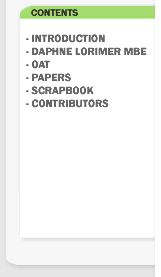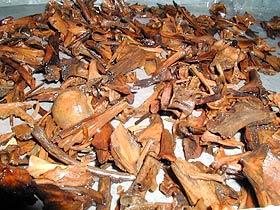


| The Fish Eaters of Viking Age Orkney |
|||||
Daphne's Salmon
I first met Daphne Lorimer and her husband Ian in the summer of 1990, while participating in Colleen Batey and Christopher Morris' excavations at the Earl's Bu, Orphir. Their home overlooked the excavation at a distance, and like so many of Orkney's heritage initiatives, they warm-heartedly adopted the project and its staff. I remember the fine afternoon when Chris Morris first took me to meet the Lorimers, and Daphne's letter to The Orcadian championing the project. I particularly remember the luxurious evening banquet they put on for a bedraggled cohort of diggers (otherwise managing on a self-made diet of generic field grub). Although memorable enough of its own accord, I have a constant reminder of the feast. With a little help in the kitchen from our hostess, I left the Lorimers with one of my first zooarchaeological reference specimens - Daphne's salmon. I write this short piece in thanks to a generous and enthusiastic champion of all aspects of Orkney's archaeology. Introduction
Did Viking Age Orcadians eat fish? This is a simple question to which one might expect a commonsensical response in an archipelago of 70 or more islands. The answer, as one might expect, is yes. Stable carbon isotope analysis indicates that some individuals may have derived over 30 per cent of their dietary protein from marine sources in the 9th to 11th centuries. Moreover, some Viking Age middens have yielded as much fish bone as mammal bone, the latter comprising the cattle, sheep and pigs we might expect of an agricultural community. A more illuminating question might thus be 'why does it matter?'. This brief paper will attempt a partial answer to this more complex problem. It will consider, in turn, the issues of:
Environmental Determinism Do all island dwellers eat fish? We know from ethnographic examples, contact period Tasmania for example, that this is not the case. One's environment may constrain the range of human choice, but the landscapes and seascapes people choose to exploit do vary. Archaeological evidence demonstrates that coastal communities of the Baltic and North Atlantic (such as Bornholm, coastal Norway and later Iceland ) did rely heavily on marine resources in the first millennium AD. Bones from fishes of the cod and herring families are particularly common finds (with cod species dominant in the Atlantic region and herring most abundant in the Baltic). They were thus economically and socially important, influencing daily and seasonal routines in a variety of ways. Conversely, marine fish were of very little importance in coastal England until the 11 th century. These differences in the economic importance of the sea can emerge across both space and time. In the case of Orkney, we now know that Middle to Late Iron Age sites yield only modest numbers of bones, most of which are from small fish easily caught from shore. Of these species, immature saithe (a cod family species) are typically most important. In recent centuries they were traditionally caught from the shore itself, or very close to shore, using lines or nets. Although valued as a food - particular for the poor - their livers were also boiled to produce crucial lamp oil. These fish may thus have played an important practical role in Iron Age Orkney - indoor lighting - but isotopic and zooarchaeologoical evidence both imply that their dietary significance was limited. If archaeology requires a cautionary tale regarding the danger of environmental determinism, the fish bones of Iron Age Orkney can provide one. Diet and Identity In contrast to the Iron Age pattern of a few small fishes, Viking Age sites contain much larger amounts of fish bone from much larger fish. At some point in the 9 th to 10 th centuries, fishing and fish consumption became a major focus of Orcadian life. It is difficult to date the existing stable isotope data definitively to this period, but Viking Age middens tell a clear story. Saithe continued to be important, but larger individuals were caught, along with large cod and ling. There are many possible explanations for this change, but one reasonable hypothesis is that it represents a tradition introduced from Norway where this distinctive combination of species had long been an economic staple. A partial list of alternative explanations might include the introduction of Christian fasting practices or population growth. Fishing Intensity, Demography and Trade Although the importance of fishing for large cod family species probably began early in the Viking Age, it reached its ultimate expression in the following Middle Ages. Starting in the eleventh century, we find settlements with distinctive 'fish middens' in both Orkney and Caithness (see figure). They are composed mostly of marine shell (probably bait), peat ash and bones of large cod, saithe and ling. Examples include St. Boniface in Papa Westray, excavated by Chris Lowe, and Quoygrew, Westray, presently under excavation by the author. These deposits probably represent semi-specialised processing middens, perhaps for the production of dried and salted fish. Less specialised domestic middens from the Middle Ages, at Orphir for example, also include more fish bone than earlier Viking Age deposits. This further increase in the importance of sea fishing was concurrent with similar developments now recognised in England and Belgium - and with the growth of trade in cured cod and herring in North-western Europe as a whole. If this pattern is not coincidental, it is possible that Orkney (a Norwegian colony) participated in the export of dried cod better documented for Norway itself. By the 13 th century stockfish may have constituted approximately 80% of that kingdom's exports. It is also clear, however, that much of the increase in fishing was for local consumption. Bones from fresh and cured fish are found in domestic middens as well as processing dumps. It is difficult to isolate one explanation for the 11 th century increase in fish consumption. As suggested for earlier Viking Age developments, changes in Christian fasting practices or population levels may be relevant. The end of the first millennium represents both the traditional (although disputed) conversion date for Orkney and a period of sustained demographic growth throughout Europe . Climate change has also been implicated in the past. This explanation is not convincing, however, as AD 1000 probably represented the height of the medieval warm period and thus a productive time for agriculture rather than fishing. Whatever the ultimate explanation for this development, it is likely to reflect Orkney's interdependence with the wider world of medieval Europe given the contemporary increase in sea fishing around the North Sea . Marine Reservoir Correction and the Dating of Human Burials This brief survey has outlined broad trends in the importance of fishing and fish consumption from the Iron Age to the Middle Ages. Unlike their Iron Age predecessors, Viking Age and medieval Orcadians did eat fish, and a lot of it. An important corollary of this observation is the fact that the carbon from these fish will have been incorporated into the bone protein of their human consumers. It is this protein, collagen, that is ultimately used for radiocarbon dating of human burials. This has serious implications for the dating of Viking Age and later graves in Orkney because, to oversimplify, the ratio of radioactive to stable carbon differs between the atmosphere and ocean at any one time. Carbon from a purely marine source will produce a date approximately 400 years or more older than a radiocarbon assay on a terrestrial material of the same age. Correcting for this difference is difficult enough when a completely marine material, such as shell, is dated. It is even more problematic when accounting for a proportion of marine carbon derived from only part of someone's diet. Fortunately, it is possible to estimate the proportion of marine carbon consumed by an individual using stable isotope analysis. Thus a very approximate correction for what is known as the 'marine reservoir effect' can be derived when calibrating radiocarbon dates on human bone. Nevertheless, work of this kind remains very 'rough and ready'. Much more research is required in order to properly address the problem. What is critical, however, is for it to be recognised. Before 1999 there were no published marine reservoir corrections of radiocarbon dates on Scottish human bone, despite the fact that some medieval middens have produced over 90% fish bone. Past interpretations of burial practices in Viking Age and medieval Orkney were thus based on potentially meaningless dates. Only now is it possible, for example, to compare Viking Age burials with and without grave-goods - the former datable by artefacts, the latter by radiocarbon. The study of fish bone has thus had critical implications for the chronology of Orkney's early historic period. Conclusions Perhaps contrary to expectations, the superficially obvious question 'did Viking Age Orcadians eat fish?' has led to several illuminating observations regarding late prehistoric and early historic Orkney. Despite its maritime environment, only small numbers of small fish were used in pre-Viking Age Orkney (perhaps as much for lamp oil as food). Fishing on a substantial scale, principally for large cod, saithe and ling, was first conducted in the Viking Age and may be related to the introduction of Scandinavian subsistence practices (although other explanations are also conceivable). The practice of sea fishing was then further intensified in the eleventh century, concurrent with similar developments around Europe . This increase may have served both an export trade and increasing local need at a time of population expansion, but these interpretations remain hypothetical. There is not yet a convincing explanation for the 11 th century increase in sea fishing that can apply to all the regions around the North Sea where it has been recognised. The Orcadian fish bone evidence does imply, however, that the archipelago was economically intertwined with the rest of medieval Europe . Finally, knowledge that Viking Age and later Orcadians were avid fish eaters has had profound implications for the interpretation of radiocarbon dates on human bone - and thus the interpretation of burial evidence. These conclusions are not intended to imply that fish bones are one of the most important elements of Orkney's archaeological record. Clearly the region's prehistory cannot be written using one aspect of material culture. It is hoped, however, that they may illuminate the value of focusing on a superficially esoteric body of evidence, and exploring how it relates to the kaleidoscope of past human experience. This work is one example of the kind of specialist study both practiced and encouraged by Daphne Lorimer, and is thus dedicated to her on the occasion of her retirement. Acknowledgements This work summarises past and forthcoming work conducted by the author and the many other fish bone specialists who have worked in Orkney and Caithness (Sarah Colley, Ruby Cerón-Carrasco, Jennifer Harland, Andrew Jones, Alison Locker, Rebecca Nicholson and Rachel Parks deserve special mention). The interpretation that Iron Age fishing was largely for lamp oil has been argued by Rebecca Nicholson and Ruby Cerón-Carrasco. References
|
|||||



